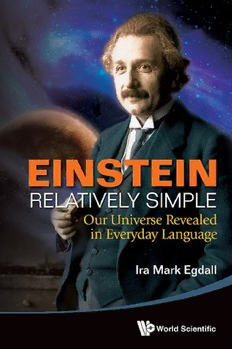
Einstein Relatively Simple: Our Universe Revealed in Everyday Language PDF
Preview Einstein Relatively Simple: Our Universe Revealed in Everyday Language
EINSTEIN RELATIVELY SIMPLE Our Universe Revealed in Everyday Language 8915_9789814525589_tp.indd 1 15/11/13 10:52 AM b1627 Einstein Relatively Simple b1627_FM TThhiiss ppaaggee iinntteennttiioonnaallllyy lleefftt bbllaannkk bb11662277__FFMM..iinndddd iiii 1111//1155//22001133 66::3344::1144 AAMM EINSTEIN RELATIVELY SIMPLE Our Universe Revealed in Everyday Language Ira Mark Egdall World Scientific NEW JERSEY • LONDON • SINGAPORE • BEIJING • SHANGHAI • HONG KONG • TAIPEI • CHENNAI 8915_9789814525589_tp.indd 2 15/11/13 10:52 AM Published by World Scientific Publishing Co. Pte. Ltd. 5 Toh Tuck Link, Singapore 596224 USA office: 27 Warren Street, Suite 401-402, Hackensack, NJ 07601 UK office: 57 Shelton Street, Covent Garden, London WC2H 9HE Library of Congress Cataloging-in-Publication Data Egdall, Ira Mark, author. Einstein relatively simple : our universe revealed in everyday language / Ira Mark Egdall. pages cm Includes bibliographical references and index. ISBN 978-9814525589 (hard : alk. paper) -- ISBN 978-9814525596 (pbk) 1. Einstein, Albert, 1879-1955--Influence. 2. Relativity (Physics) I. Title. QC16.E5E25 2013 530.11--dc23 2013033953 British Library Cataloguing-in-Publication Data A catalogue record for this book is available from the British Library. Copyright © 2014 by World Scientific Publishing Co. Pte. Ltd. All rights reserved. This book, or parts thereof, may not be reproduced in any form or by any means, electronic or mechanical, including photocopying, recording or any information storage and retrieval system now known or to be invented, without written permission from the Publisher. For photocopying of material in this volume, please pay a copying fee through the Copyright Clearance Center, Inc., 222 Rosewood Drive, Danvers, MA 01923, USA. In this case permission to photocopy is not required from the publisher. In-house Editor: Rhaimie Wahap Typeset by Stallion Press Email: [email protected] Printed in Singapore b1627 Einstein Relatively Simple b1627_FM To the memory of my father, who taught me to appreciate the wonders of science. To the memory of my mother, who taught me to see beauty in the world. bb11662277__FFMM..iinndddd vv 1111//1155//22001133 66::3344::1144 AAMM b1627 Einstein Relatively Simple b1627_FM TThhiiss ppaaggee iinntteennttiioonnaallllyy lleefftt bbllaannkk bb11662277__FFMM..iinndddd vvii 1111//1155//22001133 66::3344::1144 AAMM b1627 Einstein Relatively Simple b1627_FM About the Author IRA MARK EGDALL Einstein Relatively Simple Ira Mark Egdall is the author of the eBook Unsung Heroes of the Universe and a popular science writer for DecodedScience.com. He is a retired aerospace program manager with an undergraduate degree in physics from Northeastern University. Mark now teaches lay courses in modern physics at Lifelong Learning Institutes at Florida International University, the University of Miami, and Nova Southeastern University. He also gives entertaining talks on Einstein and time travel. When not thinking about physics, Mark spends his time playing with his grandchildren and driv- ing his wife of 45 years crazy. www.iramarkegdall.com vii bb11662277__FFMM..iinndddd vviiii 1111//1155//22001133 66::3344::1155 AAMM b1627 Einstein Relatively Simple b1627_FM TThhiiss ppaaggee iinntteennttiioonnaallllyy lleefftt bbllaannkk bb11662277__FFMM..iinndddd vviiiiii 1111//1155//22001133 66::3344::1155 AAMM b1627 Einstein Relatively Simple b1627_FM Prologue All knowledge begins in wonder. Aristotle In June of 1905, former high-school drop-out and lowly patent clerk Albert Einstein published a paper in the German Annals of Physics which revolutionized our understanding of space and time. What came to be known as the theory of special relativity predicted a strange new uni- verse where time slows and space shrinks with motion. In that same journal, Einstein proposed light comes in discreet pack- ets of energy we now call photons. Along with Max Planck’s work, this insight sparked the quantum revolution. This in turn set off the greatest technological revolution in human history — enabling the invention of television, transistors, electronic digital computers, cell phones, digital cameras, lasers, the electron microscope, atomic clocks, MRI, sonograms, and many more modern-day devices. Einstein’s follow-up article in September of 1905 proposed that mass and energy are equivalent. His famous equation, E = mc2, came to solve one of the great mysteries of modern science — how the Sun and stars shine. Some four decades later, Einstein’s breakthrough ushered in the atomic age. In December of 1915, Albert Einstein — now Professor of Theoretical Physics at the University of Berlin — surpassed his already staggering ix bb11662277__FFMM..iinndddd iixx 1111//1155//22001133 66::3344::1155 AAMM
